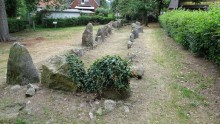|
|
|
|
Wechte IAllee-Couverte
|
||||||||||||||||||
|
|
|
Images (click to view fullsize) |
|
Photographs:



 Maps / Plans / Diagrams:
Maps / Plans / Diagrams:

|
Fieldnotes |
|
|
The gallery grave Wechte I lies south of the Bodelschwing church, a small unpaved road (An der Papiermühle) leads from the Brochterbecker Straße, where there is a sign, in about 60m directly to the tomb. The tomb lies on a green meadow surrounded by hedges, behind some houses. The tomb is quite impressive (35 x 2.5m), according to the information board it was once at least 40m long (probably on the northeast side, as there is an end stone in the southwest section. All in all a very nice tomb and due to the easy accessibility highly recommended, if you are in this part of the country. Visited July 2018 |
26th August 2018ce Edited 22nd December 2018ce |
|
Text taken from the information board: Discovered by accident During sand harvesting in 1928 a hitherto unknown megalithic grave was touched and then and dug out. At that time the approximately 2.5 m wide grave was still preserved on a length of about 35 m. Originally it must have been at least 40 meters long. The megalithic grave Langerich-Wechte I is one of the oldest and prehistoric relics of our region still visible in the area. The formerly mounded burial chamber served in the period from 3400 to 2850 BC a rural community as a collective burial ground. It was built by the farmers, who were based in the Münsterland area. In addition to agriculture and livestock, hunting, fishing and gathering wild fruits and nuts supplemented the food supply. Settlements of this time are not yet known from the immediate vicinity of the megalithic grave, but in the area Heek, county Borken, remains of the then wooden houses were discovered. At the time of the excavation, the stone-paved chamber floor was still intact. However, the larger granite and Osning sandstone blocks of the side walls and the ceiling had previously either pulled out or sunk deeper into the ground to allow for agricultural use of the area. Occasionally, dry masonry from flat rocks filled the up to 1 m wide gaps between the supporting stones. Access to the burial chamber could not be clearly determined during the archaeological examination, it was perhaps from a narrow side. In addition to numerous human bones, the excavations revealed the remains of several hundred ornate pottery vessels of the funnel beaker culture, several flint and rock axes, weapons and tools made of flint and bone and jewelry made of amber, quartz, gagat and copper. The site of Lengerich-Wechte is one of the most southerly examples of the megalithic tombs spread over the northern German-Scandinavian area. After completion of the excavations 1928, the state was preserved and some of the remaining supporting stones set up again. In addition, some of the stones of a second destroyed megalithic tomb about 800 meters southwest were used for the reconstruction. Visited July 2018 |
26th August 2018ce Edited 26th August 2018ce |
Links |
|
Das Großsteingrab von Lengerich-Wechte @ Altertumskommission für WestfalenGerman website of the Antiquities Commission for Westphalia with a short description and a 3D model (takes some time to load). In addition, it is possible to order the corresponding booklet (alson in German) from the series "Megalithic graves in Westphalia" with the current state of research on the megalithic grave on the website. |
22nd December 2018ce |

